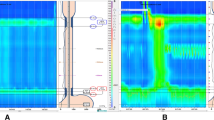Abstract
Introduction
Little is known concerning the interaction of achalasia and pregnancy and about an optimal time and type for treatment. Achalatic women of our collective of patients with at least one pregnancy in their history resulting in confinement or miscarriage were invited for a structured interview.
Materials and methods
43 of 109 female patients were included. Questionnaire contained questions on symptoms, type of symptoms, whether patients could link a specific event with outbreak of disease. Date of primary diagnosis and individual therapies were double checked against our documentation as well as duration of complaints and kind of therapy. Patients were asked about their obstetric history, whether and how symptoms had changed, and during which pregnancy week symptoms have occurred. Temporal correlation of the diagnosis of achalasia and pregnancy was investigated.
Results
There was no relationship between pregnancy and onset of achalasia. Risk of subfertility, undernourishment, premature birth, or miscarriage does not seem to be increased in achalasia. Health condition often worsened significantly during pregnancy, mainly in the first trimester and particularly in the untreated patients.
Conclusions
It is advisable to clarify the diagnosis if symptoms suspicious of an achalasia are present before a planned pregnancy. In case of manifest achalasia, surgical treatment should be performed before pregnancy and the improvement in the state of health should be anticipated, as, otherwise, a considerable deterioration of the symptoms during pregnancy may occur. Scientific impact of our observations is very limited and prospective clinical trials are required.









Similar content being viewed by others
Abbreviations
- SPSS:
-
Statistical package for the social sciences
- w/g:
-
Week of gestation
References
Enestvedt BK, Williams JL, Sonnenberg A (2011) Epidemiology and practice patterns of achalasia in a large multi-centre database. Aliment Pharmacol Ther 33(11):1209–1214
Farrukh A, DeCaestecker J, Mayberry JF (2008) An epidemiological study of achalasia among the South Asian population of Leicester, 1986–2005. Dysphagia 23(2):161–164
Arber N, Grossman A, Lurie B, Hoffman M, Rubinstein A, Lilos P et al (1993) Epidemiology of achalasia in central Israel. Rarity of esophageal cancer. Dig Dis Sci 38(10):1920–1925
Gennaro N, Portale G, Gallo C, Rocchietto S, Caruso V, Costantini M et al (2011) Esophageal achalasia in the Veneto region: epidemiology and treatment. Epidemiology and treatment of achalasia. J Gastrointest Surg 15(3):423–428
Kim E, Lee H, Jung HK, Lee KJ (2014) Achalasia in Korea: an epidemiologic study using a national healthcare database. J Korean Med Sci 29(4):576–580
Mayberry JF, Atkinson M (1988) Incidence of achalasia in New Zealand, 1980–84: an epidemiological study based on hospital discharges. J Gastroenterol Hepatol 3(3):247–252
Sonnenberg A (2009) Hospitalization for achalasia in the United States 1997–2006. Dig Dis Sci 54(8):1680–1685
Ho KY, Tay HH, Kang JY (1999) A prospective study of the clinical features, manometric findings, incidence and prevalence of achalasia in Singapore. J Gastroenterol Hepatol 14(8):791–795
Howard PJ, Maher L, Pryde A, Cameron EW, Heading RC (1992) Five year prospective study of the incidence, clinical features, and diagnosis of achalasia in Edinburgh. Gut 33(8):1011–1015
Mayberry JF, Atkinson M (1987) Achalasia and pregnancy. Br J Obstet Gynaecol 94(9):855–859
Ohno Y, Kawai M, Shibata Y, Arii Y (2000) Esophageal achalasia in pregnancy. Am J Perinatol 17(1):53–55
Clemendor A, Sall S, Harbilas E (1969) Achalasia and nutritional deficiency during pregnancy. Obstet Gynecol 33(1):106–113
Karjalainen AO (1964) Achalasia of the oesophagus in association with pregnancy. Acta Obstet Gynecol Scand 43:19–27
Khandelwal M, Krueger C (2011) Diaphragmatic hernia after laparoscopic esophagomyotomy for esophageal achalasia in pregnancy. ISRN Gastroenterol 2011:871958
Eckardt VF (2001) Clinical presentations and complications of achalasia. Gastrointest Endosc Clin N Am 11(2):281–292
Gnoth C, Godehardt E, Frank-Herrmann P, Friol K, Tigges J, Freundl G (2005) Definition and prevalence of subfertility and infertility. Hum Reprod (Oxford, England) 20(5):1144–1147
Donahue SM, Kleinman KP, Gillman MW, Oken E (2010) Trends in birth weight and gestational length among singleton term births in the United States: 1990–2005. Obstet Gynecol 115(2 Pt 1):357–364
Schleußner E (2013) Drohende Frühgeburt: prävention, Diagnostik und Therapie. Dtsch Arztebl Int 110(13):227–236
Slama R, Ballester F, Casas M, Cordier S, Eggesbø M, Iniguez C et al (2014) Epidemiologic tools to study the influence of environmental factors on fecundity and pregnancy-related outcomes. Epidemiol Rev 36(1):148–164
Gnoth C, Godehardt D, Godehardt E, Frank-Herrmann P, Freundl G (2003) Time to pregnancy: results of the German prospective study and impact on the management of infertility. Hum Reprod (Oxford, England) 18(9):1959–1966
Jensen TK, Scheike T, Keiding N, Schaumburg I, Grandjean P (2000) Selection bias in determining the age dependence of waiting time to pregnancy. Am J Epidemiol 152(6):565–572
Fiest TC, Foong A, Chokhavatia S (1993) Successful balloon dilation of achalasia during pregnancy. Gastrointest Endosc 39(6):810–812
Aggarwal R, Shahi HM, Misra A (1997) Esophageal achalasia presenting during pregnancy. Indian J Gastroenterol 16(2):72–73
Wataganara T, Leelakusolvong S, Sunsaneevithayakul P, Vantanasiri C (2009) Treatment of severe achalasia during pregnancy with esophagoscopic injection of botulinum toxin A: a case report. J Perinatol 29(9):637–639
Spiliopoulos D, Spiliopoulos M, Awala A (2013) Esophageal achalasia: an uncommon complication during pregnancy treated conservatively. Case Rep Obstet Gynecol 2013:639698
Author information
Authors and Affiliations
Contributions
TV: manuscript writing, data analysis. RMW: data collection, data analysis. OG: data management. SL: data management. HF: project development. BK: project development
Corresponding author
Ethics declarations
Conflict of interest
The authors have no conflicts of interest to declare in connection with this article.
Rights and permissions
About this article
Cite this article
Vogel, T., Wrobel, R.M., Graupner, O. et al. Esophageal achalasia and pregnancy: own observations in 43 patients and a review of the literature. Arch Gynecol Obstet 298, 511–519 (2018). https://doi.org/10.1007/s00404-018-4819-0
Received:
Accepted:
Published:
Issue Date:
DOI: https://doi.org/10.1007/s00404-018-4819-0




